#Industrial Computer Accessories
Explore tagged Tumblr posts
Text
Application of industrial control screens in intelligent security
Industrial control screens play a vital role in the field of intelligent security. They are widely used in monitoring, data analysis, early warning and alarm, and provide efficient and reliable visual support for security systems.
1. Video monitoring and processing
The industrial control screen is the core display device of the security monitoring system. It can display multiple monitoring videos in real time and support high-definition, multi-screen display and picture-in-picture functions. By cooperating with the industrial computer, the industrial control screen can realize video recording, storage, playback and real-time transmission, providing comprehensive video support for security monitoring. For example, in the smart city monitoring center, through the 55-inch LCD splicing wall, 16 channels of 4K signals can be displayed synchronously, combined with intelligent analysis algorithms, abnormal behaviors can be automatically marked and early warnings can be pushed.
2. Intelligent analysis and early warning
The industrial control screen supports advanced image recognition and analysis technologies, such as face recognition, license plate recognition and behavior analysis. These functions can help the system quickly and accurately identify abnormal behaviors or potential threats, and trigger early warning or alarm mechanisms. For example, in some intelligent security systems, the industrial control screen cooperates with the liveness detection algorithm to achieve millisecond-level response, shortening the identity verification time of the customs clearance personnel from 8 seconds to 2 seconds, with an accuracy rate of up to 99.6%.
3. Data storage and management
The industrial control screen is usually used in conjunction with the industrial computer, with a large-capacity storage device, which can save a large amount of monitoring data and image information. At the same time, it also supports rapid retrieval and playback of data to ensure the security and integrity of the monitoring data.
4. Environmental adaptability
The industrial control screen adopts a wide temperature design (-10℃ to 60℃), anti-electromagnetic interference, dustproof and waterproof structure to ensure stable operation in the monitoring room and outdoor scenes. For example, in the case of oil drilling platform monitoring, the industrial control screen still maintains 99.2% display stability under salt spray corrosion and severe vibration environment.
5. Intelligent interaction and operation
The industrial control screen supports a variety of interaction methods, such as capacitive touch screens and gesture recognition algorithms, so that monitoring personnel can quickly locate abnormal images by dragging and zooming, improving operation efficiency. For example, actual tests at a financial monitoring center showed that the event processing efficiency was improved by more than 60% through the use of an industrial control screen with an integrated capacitive touch screen.
About Us: Shenzhen Zhiyan Optronics Co., Ltd. (zylcdshop.com) is a trusted LCD screen distributor based in China. We are dedicated to providing high-quality products and tailored support to meet your unique LCD display requirements.
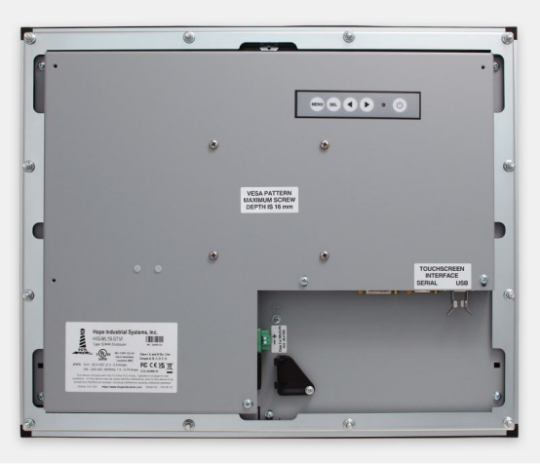
#interactive display#TFT COLOR LCD MODULE#touch monitor Display#lcd panel#lcd touch panel#lcd screen#touch screen#lcd module#Plastic injection machine LCD#lcd modules#touch panel#Industrial Computer Accessories#for sharp industrial monitor model#LCD Monitors#lcd projector
0 notes
Text

UTL IT SOLUTION
Rent-to-own your Home desktop computer at Rent-A-Center and you also receive some amazing benefits. Our Worry-Free Guarantee means you don't have to worry about credit**. Pick out your Home desktop computer and choose from a weekly, bi-weekly, semi-monthly, or monthly payment option. And if you need delivery and professional set up in your home ASAP, we're here to help with that, too. We'll deliver your new computer straight to your home and get it ready for you to use without charging you an extra dime — even on the same day in some cases. Also, if a better computer comes onto the market, you can take advantage of it quickly. Call your local Rent-A-Center, and we'll assist you in upgrading your computer to a newer model.
Stop dreaming about a new computer, and start owning one! Explore Home desktop computers online, or visit a Rent-A-Center near you to shop top-of-the-line computers near you. www.utlitsolution.com
0 notes
Text
Insights into the Dynamic Tech Market

Dive into the dynamic tech market with profound insights into the Computer Peripherals and PC Accessories Market. Uncover major players shaping this ever-evolving realm, exploring trends that define the intricate world of tech accessories and peripherals.
#Computer Peripherals Market#Computer Peripherals Market Industry#Computer Peripherals Market Size#Computer Peripherals Market Trends#PC Accessories and Peripherals Market#Computer Peripherals Market Major Players
0 notes
Text
Foxfire ROS
After playing Foxfire for 9 rounds I've started to feel like I could use something to nudge me out of my routines a bit! For the next round, I'm going to try how adding random scenarios to the mix feels like 😁
I didn't find any existing scenario lists to be exactly what I wanted: more gameplay prompts that leave room for interpretation, and not so many strict rules or tasks or forced drama (my sims create enough of that as it is lol).
So I cherry-picked some scenarios that I liked, edited others, and created many new ones. A shout-out to @kayleigh-83 for this list that was a great starting point!
Night out: Visit a community lot after dark.
Bring your own basket: Visit a park with family or friends.
Movie marathon: Invite friends over for movies and snacks, or go on a movie binge by yourself.
Family matters: Invite over a relative or someone you share a similar bond with.
Fits like a glove: Wear a new accessory.
Games night: Set up a board game or fire up a console for an evening. PC owners can throw a lan party.
Burn off steam: Devote a day to exercising in any form.
Playing hooky: A child or teen skips one school day.
Online friends: Spend an evening chatting over the internet.
Fence-mending: Talk to a walkby you don't know or have a low relationship with.
Fertile ground: Get a new plant to your garden or other outdoor area.
Pulling strings: Use influence to your advantage.
Tired of cooking: Order delivery for a meal.
Peculiar flavor: The sim with the least cooking points takes the cooking turn.
Sprucing up: Choose a room or space and give it a facelift.
Touch base: Call the friend you currently have the lowest relationship score with.
Dine out: Eat at a restaurant.
New hobby: Try out a hobby you haven't explored before.
Broken record: Talk about your favorite hobby to every sim you encounter during one day.
Slumber party: Invite friends for a sleepover.
Power outage: Turn off all the lights except for candles and only make uncooked meals for a day.
Cloud over a head: Argue with every sim you encounter during one day.
Old gang: Meet up with the friends you have known for the longest.
Turn up the heat: Woohoo in public.
New ink: Get a tattoo.
Fresh air: Spend a day outdoors.
Homebody: Spend a day indoors.
Got the moves: Visit a community lot to hit the dance floor or turn on a stereo at home and dance until you run out of energy.
Make the bed: Change sheets for all beds on the lot.
Health concerns: Visit or call over a doctor.
All things are transient: Sell three objects.
Odd bottle: Consume a potion from your inventory.
Dig it: Spend a day treasure hunting.
Capture it: Take a picture and hang it on the wall.
Running on fumes: Have a cup of coffee once every few hours.
Reaching enlightenment: Meditate for a day.
Sugar rush: Prepare only desserts for a day.
Clocking extra time: Spend an evening on a computer either blogging, writing, or giving financial advice.
Dressed to the nines: Go on a date in formalwear.
Pretty lights: The outdoor areas of the lot are filled with fireflies for the round.
School assignment: A child or teen collects bugs for the round.
Stealing the show: Perform with an instrument or a microphone, freestyle for tips, or breakdance in public.
Devil on a shoulder: Prank every sim you encounter during one day.
Turning the page: Negative relationship effects are reduced for 48 hours and any existing fury states are cleared (get the 'forgiving' vacation benefit).
Meeting deadlines: Job performance is increased for 48 hours (get the 'industrious' vacation benefit).
Hot stuff: The attractiveness is increased for 48 hours (get the 'je ne sais quoi' vacation benefit).
On the ball: Skill, talent badge, and homework rates are increased for 48 hours (get the 'refreshed' vacation benefit).
Scatterbrained: Skill, talent badge, and homework rates are decreased for 48 hours (get the 'jetlagged' vacation penalty).
Bonfire night: Light up a bonfire with family or with friends.
Explosive entertainment: Throw a party with fireworks.
By example: Share hobby tips or instruct someone in a hobby, or find a sim who can share tips or instruct you in one.
Score points: Visit a community lot to play arcade games, poker, don't wake the llama, mahjong, or myshuno.
Self-care: Skilling is forbidden for a day. Instead, practice recovering activities like taking bubble baths, enjoying hot tubs or hot springs, getting massages, relaxing in saunas, or sunbathing.
Feeling chipper: Compliment every sim you encounter during one day.
I'll probably add these whenever I come up with new ones. Scenario ideas are welcome!
#text post#foxfire forest#ts2#the sims 2#sims 2#*appears out of nowhere to post this*#i hope these will be fun!#i left out some obvious ones like changing clothes or hairstyle#as i tend to plan those in body shop
133 notes
·
View notes
Text
»zenless zone zero«
Small details in Wise's room. I'll admit I struggled a little on this one. (No offense to Wise lovers, he's just not super interesting to me. But I did my best!)
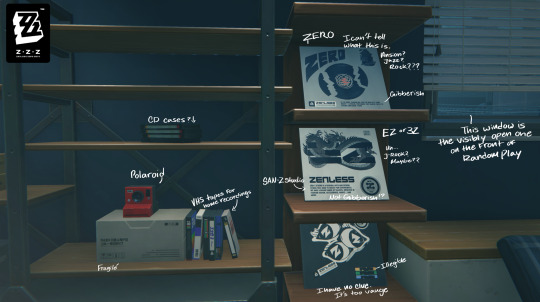
[Desc: Next to Wise's bed is a brown shelf beside an industrial style shelf, made of wood & metal. Like Belle's room, the standing shelf holds record sleeves. The first one is white with art of a black record that is broken in thirds, with large box letters that say 'ZERO'. The art is vague which makes it hard to speculate what style of music it might be. I guess...Jazz? That's a guess purely on vibes, really. The second record sleeve is black, white, and grey. On a white background there is a grey (traditional style) dragon wrapping around the studio's logo, EZ or 3Z, I'm not sure which. There's text that says 'ZENLESS', and underneath that, some descriptive text. The descriptive text is more legible than others. It says - "SAN-Z Studios is a general arts and design studio that aims to create fun experiences. We have a broad range of talents, involved in fashion design, accessories, music...and more." The third record sleeve is black with art of three eyes, each with a 'Z' in the iris. It's far too vague for me to guess what style of music it is. On the industrial shelf is a cardboard box with a red polaroid camera on top, and some VHS tapes leaned against it. These VHS tapes have no branding, which once again makes me think these are the tapes one would buy for personal recordings. On the shelf above it are three non-descript cases. They seem too thin for VHS tapes, and too big for a walkman tape. This makes me think they're CD cases.]
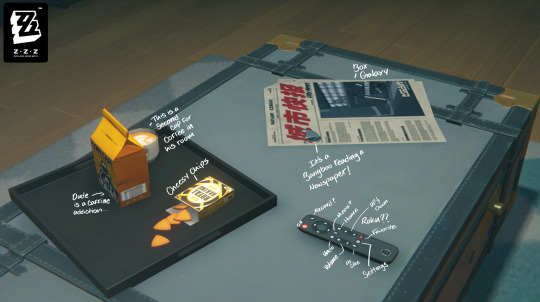
[Desc: On the coffee table(that is a trunk style coffee table) is a tray with an open package of 'Royal Baking' chips/crackers. Based on coloring, I'd guess they're cheesy. Beside the open cracker package is a bag of Coff Coffee, made by the Tin Master. There's a cup with Tin Master's logo beside it, with coffee inside. The coffee has foam in a design. On the table is also a newspaper. The only legible writing is in kanji I cannot read, but the picture on it is of Box Galaxy, the gadget store on Sixth Street. Also, I took note that there is a little Bangboo reading a newspaper on it. Lastly, there is a remote. Despite the vintage style TVs, this remote looks akin to a modern Roku remote. Black, with rounded corners, fairly slim and small, with a simple set of buttons. On, record (potentially, the symbol is vague), a central d pad, a menu button, undo, home, a pair of volume buttons & up/down decision buttons, a settings button, a button with a red heart (to favorite things I presume), and a last button with a symbol so vague I couldn't begin to guess what it does.]
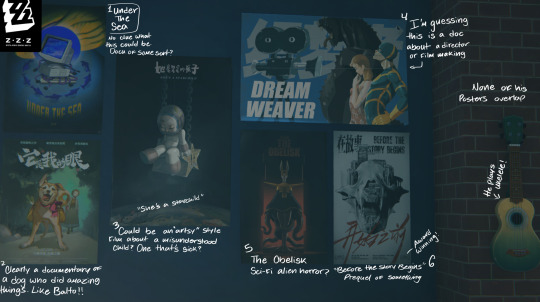
[Desc: Like Belle, Wise has movie posters on the wall beside his bed. Unlike Belle, his posters don't overlap, and seem meticulously placed. There are a total of six movie posters. Though before I describe those, I'll point out that he has a green & yellow ukulele hanging on his wall. A notable difference from Belle's electric guitar. 1) Now, the first poster features art of an old computer (think big white box computers from the 80s) in a blue & yellow ocean landscape, with dark blue fish shapes around it. The title says Under The Sea in yellow text. What this could be about, I have no clue. But Wise has been said to enjoy documentaries and artsy films. Completely based on my own headcanon and no evidence? My guess is a documentary about technology developed to explore the ocean. 2) The one underneath has a title in kanji, but the art is pretty clear. It features a shiba inu dog front and center with a "saddle" on it's back, of which has two bags on either side. The only item I can tell that is in the bag is the left one, which has the top of a leek sticking out. Behind the dog is a young woman with a long skirt, as well as some trees. I can't read the title so I'm not sure, but I'd like to think this is a documentary about a very special dog. Like Balto! 3) The third poster features art of a young girl in a space suit, sat on a swing (a wooden board with rope that goes up out of frame), over a shadowy moon that is covered in children's crayon drawings. The title is one again in Kanji, but the tagline says "She's a Starchild". Once again, the art is vague, but my guess would be an artsy kind of film with an underlying message about a young girl with a struggle of some kind. Probably a movie with a lot of metaphors and symbolism. 4) Poster number four is a horizontal kind of poster. On a blue background, there is an old film camera on the left. (A vintage one, 1930s-1950s, which used large film reels.) On the right are three figures. The one furthest to the back is Godzilla, the second is a woman in a red dress, and the third appears to be a non-descript hero character in a blue & yellow uniform. In white block text, it says "DREAM WEAVER". My guess is that this is a documentary about film making. 5) Five has art of a semi-humanoid creature standing in a red lit doorway, but at the bottom are various winding tentacles. The title says "The Obelisk". My guess is that this is a sci-fi horror movie of some sort. 6) The last poster, number six, features an animal skull (a bear skull based on my limited knowledge) on top of a white background. There is black and red kanji in a "messy" style. The English text are the words "Before The Story Begins", so it's probably a prequel of some kind. There's a vague shape in the bottom corner that looks like an award symbol.]
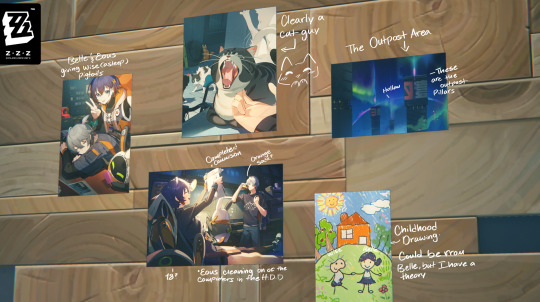
[Desc: Wise's memory board. (If you don't pick him as your MC). The back is the basic wooden style that Belle also has, and it has five pictures. The first one is a selfie taken by Belle, featuring her and Eous standing over Wise, who is sleeping, after having given him a pair of pigtails. The second picture features various cats, with one opening it's mouth for a big yawn as Wise pets it. The third picture is a picture taken by one of the Random Play Bangboo; but not Eous. Eous is in the picture, cleaning one of the screens in the H.D.D, while Belle reclines in a chair and holds up a stack of papers that has red writing - "Complete!" with a circle around it. Wise stands beside Eous with his jacket slung over his shoulder, drinking a soda. (It doesn't match the LENMAN soda in Belle's room, but I've seen vending machines in Lumina square with a drink that is orange; with oranges on it. So...Orange soda? The fourth picture is of the Hollow in the Scott Outpost area. I can tell because there are pillars that match that area. The last picture is a childhood drawing of Wise & Belle. Stood in a field, in front of an orange house. Based on the style difference, it's possible that this was a group effort. Belle's figure and various background elements seem more...uh, artistically inclined. While Wise's figure, some trees, and the flower/grass details seem more simplistic and sloppy. Which would make sense given all the artist details in Belle's room. Wise probably didn't get the artist gene.]
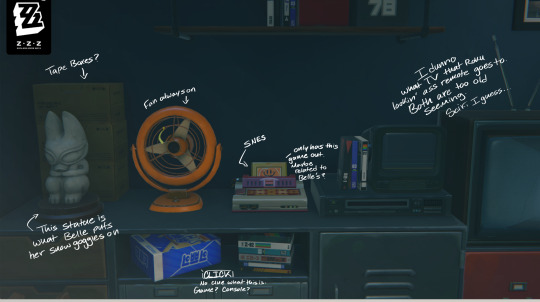
[Desc: On the cabinet beside Wise's TV (once again an old style tube television) are some knickknacks. In front of three stacked small boxes is a stature, the same one in Belle's room that she used to hold her snowboarding goggles. I guessed rabbit based on her room, but it also looks like a fox. Beside that is an orange desk fan that's always on. Further to the right is a game console, which I mention was visually similar to a Super Nintendo. There are no visible cartridges out excluding the singular one in the slot of the console, with a vague logo on the front. An orange smiley face; which could mean it's part of a series, since Belle had a game with a blue smiley face in her console. The sticker for this game is ripped at the top. Maybe it's old, or maybe he and Belle swapped games for a bit. Belle seems like she'd accidentally rip a sticker. He also has a VHS player, there's a small screen on top of it. It's tiny, like a monitor, but I'm not sure it's purpose exactly. Maybe one of those old CCTV monitors? There's some more non-descript VHS tapes leaned against it. There's a shelf as well that holds some more VHS sleeves and a blue & white box. While I've seen the box in the 141 Convenience Store, which tells me the box's branding has the word "CLICK" on it, the rest is in kanji and there's no pictures on it to hint at a product of some sort. Game? Console? ...Wireless mouse? I have no clue.]
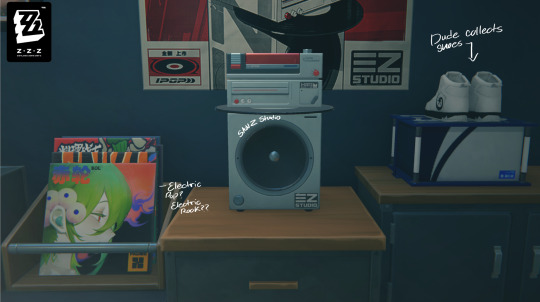
[Desc: Wise owns the same CD/Record/Tape player that Belle does. It's situated on a little table by the door. I can see now that the branding on the gadget is the same as the studio on the second record sleeve he owns, SAN-Z studio. The table has a divot to hold records. The only one with a visible front has art of a girl with vibrant green hair, in front of a black background that has bright pink, blue, and orange detailing. The girl has a hearing aid/ear bud in her ear, and an...accessory? On the side of her head. On a separate cabinet beside this is a blue & white box with a pair of black & white sneakers, which I think I've seen on one of the commercials that the game-start loading screen features.]
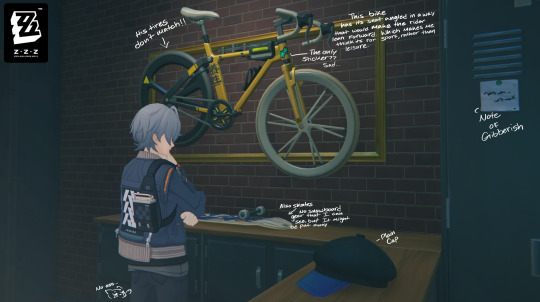
[Desc: (With a bonus Wise in frame), there is an L shaped cabinet in front of his door. On this cabinet is a plain black cap with a blue brim, and a skateboard with blue & white art on the back. I didn't seen any snowboarding gear in his room, but it doesn't mean he doesn't own it. He's neat, so it could just be put away. On the wall is a yellow bike. The back wheel is black, while the front is white. They don't match, but the front one matches the seat color of the bike, so my guess is he had to replace the back one. Also, based on the shape of the handlebars and the seat positioning, the seat is raised in a way that would make riding while sat upright hard/impossible. This seems like a bike someone must lean forward on, which means it'd be for things like trails and marathons, rather than transportation or leisure rides.]
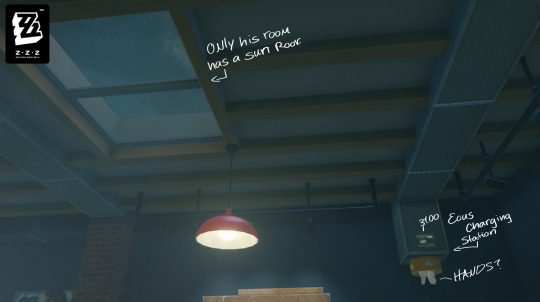
[Desc: A bit boring, but his roof is the only one with a sun roof. Belle's room doesn't have one. By his bed is also, the only window that is visibly open on the front of Random Play. Somehow, this pale boy gets more sunlight in his room than Belle. But maybe she picked that. Also, though I picked Belle (which means Eous charges in her room), Wise also has an Eous charger, just unused.]
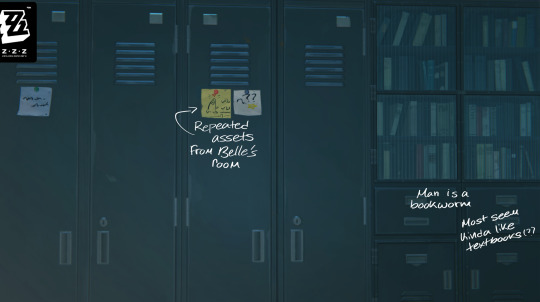
[Desc: A set of lockers with some posted notes. These seem to be reused assets from Belle's room. There is also a book case. None of the books really have any branding that allows for speculation of what they're about, but there are some colors with tiny (non-descript) details that remind me of textbooks and books about specific subject, like for learning.]
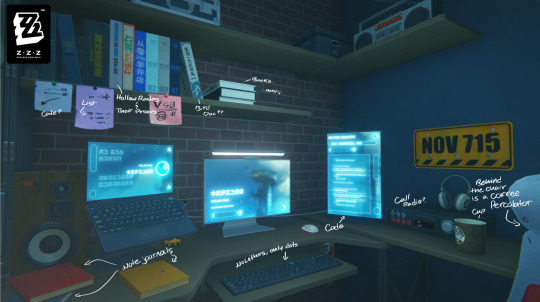
[Desc: Wise's desk. It features a standard PC screen, one of those vertical screens, and a laptop on a holder. All of which are on, glowing with blue symbols and unreadable text. There's a wireless mouse too. On the shelves over the desk are post it notes, one that seems like a list, and another that might be about code? There are also more books. Most are in kanji, but I can read one. "Hollow Raiders & Their Proxies." Beside his computers are three journals. Unlike Belle's, there are no stickers, stamps, or tabs poking out of the pages. These are note journals, each with a button latch to close them. One yellow, one red, one blue. To the right is a...radio? It looks vaguely like a call radio to me, and there's a set of headphones on top. But I'll be honest and admit I'm not sure what it is. There's also a yellow license plate on the wall - "NOV 715". There's another Tin Master mug, and while in the photo it's blocked by his aerodynamic chair, there's a metal coffee percolator. Which makes me think this dude has a caffeine addiction.]
29 notes
·
View notes
Text
I've been working on this for a long time, and I still didn't go over everything I want to go over, so this is going to end up being a multi part series on how I make my wavs, as well as a bit of general audio engineering.
Reed Behind the Scenes Part One:
Microphones and Recording Environment
A couple of notes before we begin:
For this series I'm going to focus on audio recordings, not video recordings, as they are very different mediums with different requirements. I am by no means an expert, I just have a little more experience with audio production than the average person.
All of my equipment is in the Android/Microsoft ecosystem, and as such I do not have much experience with Apple products. I apologize in advance if anything I discuss does not work within the Apple ecosystem.
Let's talk about microphones. You can't make a recording without one, whether it's the one in your phone or a standalone mic. I use the latter, but some phones have decent mics. Since we just mentioned Apple products, I will say that I have heard that the microphones in iPhones are pretty good these days. When I record on my phone, I prefer to use a dedicated recording app, because it allows me to record directly to an mp3 or wav file that I can then export to my computer for editing, as opposed to recording a video and trying to rip the audio later. I use an app called Voice Record Pro, but there are plenty of voice recording apps out there.
For my best quality work, I use my microphone. You don't need a super fancy mic to make good recordings, but the kind of mic you get is important. There are many different kinds of mics at many different price points, but they generally fall into two categories: USB and XLR. USB microphones can plug directly into your computer, whereas XLR mics need to pass through an interface first. For the vast, vast majority of people looking to get a mic for making fetish content, I am going to recommend getting a USB mic, and the main reason is cost.
For XLR mics, you need two pieces of equipment: the mic itself and an audio interface to run it through to a computer. Not to mention XLR cables, a stand, and a mount. Even if you get a relatively inexpensive XLR mic, after you get all of the other equipment and accessories you need, you may as well have splurged on a decent USB mic.
I only recommend investing in a good XLR if you want to pursue a professional audio career of some kind, and even then I'd wait to sink serious money into it until after you've gotten your feet wet and know that it's really what you want to do. These can be very difficult industries to break into. I do professional voice work, so for my setup I have a Neumann TLM 103, Focusrite Scarlett Solo audio interface, and a Surface Go tablet for recording. More on that in a bit.
In both USB and XLR there are generally three types of microphone: condenser (which is also sometimes called capacitor), dynamic, and ribbon. I'm not going to get into ribbon mics, because you don't need one just for snz content, and I'm not well-versed in them anyway. Most of the mics you will encounter when shopping for one online will be either condenser or dynamic.
Condenser mics are more sensitive than dynamic mics, so they're generally clearer and better suited for voice work. I'm using the word “generally” a lot here, because there's such a wide range of mics, and you may very well find a dynamic mic that works better for your voice and your space than a condenser mic. Unfortunately, the only way to really know for sure is to get one, try it out, and return it if it doesn't fit your needs.
There's this idea that dynamic mics are better for untreated spaces, because they're less sensitive and will therefore pick up less background noise. That's not exactly true. Dynamic mics do pick up fewer audio frequencies than condenser mics, so if you have some background noise that's outside of your mic’s frequency range, then that may not get picked up. Your average background noises, though—loud neighbors, motorcycles and trucks driving by, your cat meowing, the hum from your PC fan—those sounds will still get picked up. The best thing to do is to sound treat your space, but we'll get to that later.
I'll post a few recommendations, but I haven't used any of these mics for myself, so these are recommendations from the voice acting community at large as good budget mics. Any prices are USD, and unfortunately I don't know the global availability of these mics.
USB Mic Recommendations:
Blue Yeti USB
AudioTechnica AT2020 USB (Note that there is also an XLR version.)
Both can be purchased under $100 pre-owned. Both retail for around $130 new. If you're in the US, the nice thing about the Blue Yeti is that you can walk into just about any Best Buy and pick up a brand new one on the spot.
XLR Mic Recommendations:
RØDE NT1 5th Gen
AudioTechnica AT2020 XLR (As mentioned above.)
The AT, at about $100 new, costs less than half as much as the RØDE at $250. If you're set on an XLR but shopping on a budget, that may be the mic for you. The RØDE, on the other hand, is a great introductory mic for professional voice work. For these mics you'll need an audio interface, also called a preamp. A solid one for the budget-conscious, and what I use, is the Focusrite Scarlett Solo, which will set you back about $100 new.
The microphone I use, a Neumann TLM 103, retails for about $1,200 new. You can sometimes find them under $600 pre-owned. They're pretty much the gold standard in the animation industry for how well they can handle loud sounds, like yelling and screaming, without clipping. I invested in one several years ago when my husband got a nice bonus from work, for which I am eternally grateful. Do not go this far unless you are serious about voice work.
Now that you've learned far more about microphones than you ever wanted, let's talk about sound treatment for your recording space. Whether you're using a dedicated mic or your phone, sound treatment will always elevate the quality of your recordings. Even the highest quality mic in an untreated space will sound worse than an average quality mic in a well-treated space.
What is sound treatment? Sound treatment is taking steps to reduce and eliminate the amount of background noise and reverb from the space you are recording in. Have you ever noticed a slightly echoey quality to your voice in recordings? Like you can "hear the room"? That's reverb. When you speak, the sound waves go from your mouth to the microphone , but they also go out into the room and reflect off of the walls before coming back and hitting the microphone again, creating that slight echo. You'll need a sound treated space to prevent that from happening.
One fairly easy and inexpensive way to do this is to utilize thick moving blankets. You can try tacking them up in a closet or hanging them from a booth frame. I currently use a recording booth made from a PVC pipe frame with a double layer of moving blankets hung around it and draped overtop. (Here’s a link to a video tutorial on how to build your own). Another method is to use sound dampening panels hung on the walls of your recording space. A lot of folks use those textured foam tiles. Just be careful with those because if you get really cheap ones the foam can be poor quality that doesn't dampen sound very well. (The Foam Factory sells great acoustic foam, but the cost can add up quickly depending on the size of your space.)
I've also seen booths that are made by lining the walls of a closet with carpeting, so if you happen to have some carpet remnants that might work for you. I’m upgrading my own recording space by converting a closet into a recording booth. I'm building sound panels made from wooden frames filled with sound dampening insulation that I’ll hang on the walls. (Here's a link to that tutorial as well, but that option costs a few hundred dollars in supplies.) If nothing else, a closet filled with hanging clothes can do in a pinch to dampen background noise.
Let's talk a little bit about computers while we're on the topic of background noise. Remember way back when I mentioned my Surface Go tablet? Now remember when I talked about how mics can pick up PC fans? The Surface Go is how I get around the problem of PC fan background noise. The Surface Go doesn't have a fan, so it doesn't make any noise. I can bring it into the booth with me, hook my interface up to it, and use it to run my recording software. I'll then transfer the file to my main PC for editing. If you can do so with your space, you could potentially get cables that are long enough to leave your PC tower outside of the recording space so you can't hear the fan. Definitely cheaper than buying a tablet just for recording.
For editing, I use Audacity, which is a free digital audio workstation, or DAW. Another popular DAW is Reaper, which is "free" in that they don't limit the trial version, so you don't need to pay to use the full version (although they'd really like you to buy a license). I'm not going to go too far into depth on software and editing here, since I plan to do a Part Two on how I edit my recordings. Besides, this post has gotten long enough, and this seems as good a place as any to end it. I'm always open to questions on this kind of thing. Like I said, I'm not an expert, but I'll answer what I can, and if I don't know the answer I'll do my best to find the information for you. Thanks for reading this far, and I hope you've learned something that's helpful or at least interesting to you in some way 😊
9 notes
·
View notes
Text
Polaris Computing Ltd., more commonly known as simply Polaris, was founded by Stanford graduate students Claire Tashi and Joel Lovinger in 2002. The company rapidly rose to prominence after the release of their sophmore operating system Andromeda in 2006. Users praised the system for its balancing of desirable traits from competing companies, namely Apple and Microsoft. Blending the heavy lifting of Windows with the visual sensibilities of Apple and a level of customization offered by neither allowed the small tech startup to skyrocket into financial success and industry acclaim.
Andromeda was a major improvement over its debut OS Centauri (released in 2003), marking major shifts towards a focus on smooth and instinctive UX and UI. The desire for a smooth and highly personalized user experience was Claire's contribution, and something that truly set Polaris's products apart. Joel's contribution was in functionality and capability, pushing their OS products to the limits of technical capability.
Eventually the company began creating its own devices to pair with its software, a way to further engage devoted customers and bring in more sales. While their operating systems could be installed on any device, the launch of the Cygnus desktop computer in 2008 was a foray into a new era of the company. Joel carefully oversaw the technical details of its design, the hardware used, and together with Claire personally monitored the progress of software development for the launch of Lyra, the follow up OS to Andromeda that would debut pre-installed on all Cygnus computers. Shortly after that Polaris released their first laptop, the Gemini. It would also use the Lyra OS, and promised to replicate as much of the experience of a desktop as technologically possible. The design ethos of the company persisted, and accessorizing the Gemini became increasingly popular. The company began to sell official cases and protective equipment in a variety of colours, patterns, and materials, along with laptop bags, headphones, mice and other accessories.
What would truly cement Polaris as an untouchable tech giant was an early wave smartphone meant to compete with the Blackberry: the Lynx. Released in 2009, for a while the Lynx was the only smartphone to properly compete for the market owned by RIM and the Blackberry and Apple's iPhone. Multiple versions of the Lynx with slight modifications were released, along with models in all sorts of colours. The parade of phone cases and charms and holders would further contribute to the individualization continued.
As the market shifted heavily in favour of touchscreens, and iPhones became the dominant cellular device on the market, Polaris too shifted with the tides. In 2011, the company released their own version of a touchscreen phone, essentially a miniature tablet with added features that carried a more true-to-desktop version of Polaris's OS: the Acrux.
This pattern of call and response would continue over the next decade as the company began to balloon to titanic proportions. Its value would grow in a way that seemed exponential. With solid leadership and a better-than-average public reputation than most tech companies of the era possessed it seemed there was nowhere but up, up, and up for Polaris and its C-suite executives. Shortly before the 20 year anniversary of Centauri's release, and what was sure to be a monumental milestone for its leaders, Claire would slowly phase out of the company. With her shares sold and redistributed, and Joel able to secure over approximately 52% ownership of the company's shares, he remained on board as the sole CEO of the company and its single largest shareholder.
This shakeup was met with Joel's very own press tour; interviews in magazines, glowing reviews on tech news sites for new Polaris products, and more public appearances and charitable donations. Amid this flurry of good press was the nugget that would explode into a major story in the tech world: Claire was out at Polaris, and the Lovingers had separated. As far as the public knew it was amicable, quiet. Things have carried on, but whispers in the network have revealed cracks in the foundation. With Claire came a small exodus of loyal supporters, particularly those aware of the impending divorce. New hires worked to Joel's advantage, giving the impression of a growing and thriving company. Polaris still pulls in unconscionable amounts of revenue every year, lining Joel's pockets nicely. So far he has been unscatched, the victor, a man on top of the world.
3 notes
·
View notes
Text
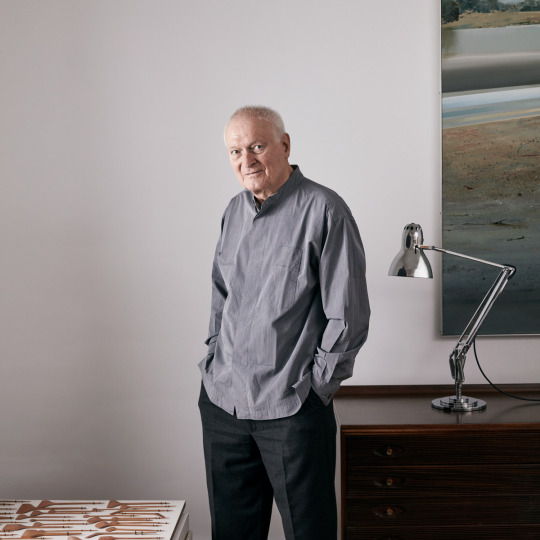
Sir Kenneth Grange
A giant of 20th-century design whose products – from food mixers to lamps and trains – became staples of British life
Kenneth Grange, who has died aged 95, was the leading British product designer of the second half of the 20th century. Even if unaware of his name, most people in Britain are familiar with his output: the Kenwood Chef food mixer, the Kodak Instamatic camera, the Ronson Rio hairdryer, the Morphy Richards iron. These everyday objects are part of all our histories. Grange was also responsible for the restyling of the InterCity 125 high-speed train and the 1997 TX1 version of the London taxi.
He was a tall, handsome, ebullient man, a joker with that element of inner moral purpose often found in the designers of his postwar generation. He grew up imbued with a determination to make the world a better place visually, his emphasis always on functional efficiency. Grange was a master at reassessing usage, but he also viewed design in terms of sheer enjoyment. He wanted us to share in the surprising grace of the experience as the 125 train comes hurtling down the track.
When he set up his own design consultancy in 1956, Grange was one of just a handful of designers operating in the world of what were then quaintly called consumer goods. Many of his early commissions came via the Council of Industrial Design (now the Design Council), a governmental body set up with the remit of improving national design standards. Grange’s commission to design Britain’s first parking meter, the Venner, introduced in 1958, came via the council. So too did his introduction to Kenneth Wood, proprietor of the firm in Woking whose domestic products were marketed as Kenwood. Grange’s clean-lined and user-friendly Kenwood Chef food mixer became a housewives’ status symbol of its time.
Like his near contemporary Vidal Sassoon, Grange came from a non-artistic background and had a similarly innate sense of visual style. Both men were quintessentially 1960s talents, Sassoon with his geometric haircuts, Grange with a succession of urbane modern products for a new, self-consciously fashionable age. He became a prime designer for the growing market in “portable accessories”: pens for Parker, cigarette lighters for Ronson, the melamine and smoked perspex Milward Courier shaver which, in 1963, won the Duke of Edinburgh’s prize for elegant design (now known as the Prince Philip Designers prize). Did Prince Philip himself use it? Grange insisted that he did.
In 1972 Grange joined four of the rising stars of his profession – Alan Fletcher, Colin Forbes, Theo Crosby and Mervyn Kurlansky – in founding the ultra-modern design group Pentagram. This was a multidisciplinary consultancy described by Grange as “a one-stop shop” providing specialist services in graphic design and advertising, architecture and – Grange’s own area – product design.
Pentagram became the bee’s knees of design consultancies: ambitious, professional, intelligent and jaunty. It attracted loyal clients, including Reuters, for whom Grange designed the Reuters monitor, a state-of-the-art computer terminal and keyboard, superbly well engineered in heavy silver aluminium sheet.
Through the 70s Grange was occupied with the most high profile of his design commissions: the aerodynamics, interior layout and exterior shaping of the nose cone of British Rail’s High Speed Train (HST). The InterCity 125 was a key element in BR’s strategy to woo passengers away from cars and planes and back on to the trains. However the first HST prototype they came up with was, in Grange’s opinion, “a lumpish, brutish thing”.
He realised he could only improve the appearance by first tackling the aerodynamics. On his own initiative (and at his own expense) he spent a week at night working with a consultant engineer at Imperial College London, where there was a wind tunnel. In the course of these experiments they developed a number of new ideas, getting rid of the buffers, hiding the couplings in the underside of the nose cone, and giving the train a more futuristic look.
It was launched in 1976 with its radical, dynamically angled nose design. Grange was always careful to give credit to the expertise of the engineers he worked with. All the same, it was his major triumph and a lasting symbol of the best of mid-20th-century British design. The HST – still in use today on selected passenger services after almost 50 years – transformed the public experience of travelling by train.
He was born in east London, the son of Hilda (nee Long), a machinist, and Harry Grange, an East End policeman. Kenneth was brought up in what he once vividly described as “a bacon-and-eggs kind of house”, respectably furnished with a three-piece suite and flowery curtains, the dominant colour being brown. Nevertheless his parents supported his chosen career in what was then termed “commercial art”. During the second world war, the family had moved to Wembley in north London, and Kenneth won a scholarship to Willesden School of Art and Crafts where, from the age of 14, he studied drawing and lettering.
These basic skills gave him the entree to a succession of architects’ offices: Arcon; Bronek Katz and R Vaughan; Gordon and Ursula Bowyer; and, from 1952, the remarkably versatile architect and industrial designer Jack Howe – all of these were modernists and prime movers in the postwar campaign to rebuild Britain using newly available materials and techniques.
Grange took part in the 1951 Festival of Britain, working alongside Gordon and Ursula Bowyer on the Sports Pavilion for the South Bank exhibition. For so many of Grange’s generation of designers – including Sir Terence Conran and my husband, David Mellor – the festival would be a lasting inspiration. As Grange later recollected: “You couldn’t walk a step without seeing something unlikely – the cigar-shaped Skylon, the huge Dome of Discovery, extraordinary metal sculptures, waterfalls that twisted and turned. Nothing was like anything I had ever seen before.”
Where much of British design was still craft-based, dominated by ideas that went back to William Morris, Grange felt the fascination of machine production. He was excited by the sleek designs based on new technology beginning to infiltrate Britain from the US, describing the moulded plastic Eames chair for example as “a rocket ship exploding into our narrow world”. I remember being impressed on my first visit to his house in Hampstead, north London, to find him the possessor of not just one Eames lounge chair but three.
Grange’s natural resilience stood him in good stead through the 70s and 80s, those lean years for designers when British manufacturing lost its way and, as he described it, “unbridled accountancy became the new dynamic in British industry”. He was glad of foreign clients, especially enjoying working in Japan where the innate Japanese awareness of design delighted him. An especially successful commission was a sewing machine designed for the Maruzen Sewing Machine Co in Osaka, to be marketed in Europe. On trips to Japan he started what became a considerable collection of beautiful wooden geisha combs.
Pentagram itself was flourishing, moving in 1984 from Paddington to larger and more stylish premises in a renovated dairy in Notting Hill. At this period it employed more than 80 designers and assistants in different disciplines, and the communal dining room became an ever-welcoming talking shop, a gathering point for London’s design world of the time. I remember some marvellous parties at Pentagram, including the celebration of Grange’s marriage in 1984 to Apryl Swift.
For Grange himself the 1980s brought increasing public recognition. In 1983 a solo exhibition of his work was held at the Boilerhouse at the Victoria and Albert Museum in London.
At this point he was already being lauded as Britain’s most successful product designer. He was made CBE in 1984, and knighted in 2013. In 1985 he received an honorary doctorate from the Royal College of Art and in 1986 became master of the elite group of Royal Designers for Industry. Success never spoilt him. He had a streak of self-denigrating humour and retained a kind of boyish innocence, as if he could hardly believe his good luck.
The sheer challenge of the job had always been his driving force. After his retirement from Pentagram in 1997, after 25 years as a partner, he and Apryl embarked on a project of their own, converting an ancient stone-built barn in the remote countryside near Coryton in Devon into a spectacular modern home with a spiral staircase of highly ingenious modular construction. Completion took five years; Grange commuted weekly between London and Devon, travelling on his familiar High Speed Train.
In 2011 the Design Museum held a retrospective, Kenneth Grange: Making Britain Modern. He continued to design into his 80s. Late commissions included the perfect men’s shirt for the fashion designer Margaret Howell; an updated range of classic lights – the Type 3, Type 75 and, in his 90th year, the Type 80 – for Anglepoise, for whom he had been made design director in 2003; and a really comfortable collection of chairs for elderly people. General levels of design for the aged population made him angry. “Where is the decent modernist care home?” he would ask.
Typical of Grange’s zany 60s humour was his design of a man-shaped timber bookcase that converted to a coffin, the ultimate exercise in recycling. “If I ever pop my clogs, it’s books out and me in, with the lid fixed, up to the great client in the sky.”
Two earlier marriages ended in divorce. Apryl survives him.
🔔 Kenneth Henry Grange, designer, born 17 July 1929; died 21 July 2024
Daily inspiration. Discover more photos at Just for Books…?
10 notes
·
View notes
Note
The gaming and tech industries are literally in a race to the bottom, and it sucks so bad. Where's all the fun innovations?!
"Capitalism leads to new innovations," they said, but I don't remember anyone asking for computers to replace jobs and cost people their lives. All so the corporations don't have to pay for labor
Learned a long, long time ago that the backbone of capitalism is the invention of a problem, and the selling of the solution. Convenience is the biggest and most lucrative commodity anyone can sell in this world, bc the world is built to be inconvenient by the exact people selling the convinence.
The PS5 Pro ( and even the Xbox and Xbox GamePass in a way ), is actually a hilariously good example of this. They purposefully remove ports, accessories, disc drives, backwards compatibility, to inconvenience you, then go “oh but you can buy it on the side… or you can spend a little more for an even better one ✨”. They convince their consumers they need that extra 30fps ( even tho depending on the game they rlly don’t ), they create bloated, unoptimized games with high resolution assets that take up waaayyy too much space and then turn around and say “hey look, our shiny new plastic box has an extra Terabyte, that’ll be $700”.
It’s giving DLC burger meme, lol.

Every industry does it now too, even health insurance in the US sells body, eye and teeth plans separately like they aren’t all attached, and affect one another. Which is why it feels so difficult to escape it, like implementing genai pulling the “can’t be bad if we’re all doing it”.
This is all by design.
Expecting innovation in Capitalism is bound to disappoint eventually, anything that focuses only on profit does. The innovativeness of the original iPhone blew us away, yes it was incredibly exciting at the time bc no one else had done it. However that innovativeness revolved around the convenience of having a phone, an MP3 player, and a computer in your pocket, and since no new piece of major tech has been invented since, is it rlly any surprise at all that every iPhone feels like the last, but just slightly bigger and more expensive?
No one was technically asking for ai, but I’m sad to say these ai companies are doing numbers rn, even if it isn’t innovative, bc ai has been around a while, corporations just took it and ran with it and made it worse and less cool, it scratches the one itch that inconvenienced consumers love, convenience!
Which is why I wasn’t at all surprised, disappointed, but not surprised to find out from a recent article that 40% of students and teachers utilize it in their coursework. 🥲
11 notes
·
View notes
Text
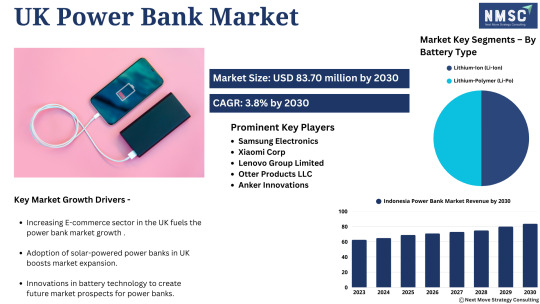
Did You Know?
The 𝗨𝗞 𝗣𝗼𝘄𝗲𝗿 𝗕𝗮𝗻𝗸 𝗠𝗮𝗿𝗸𝗲𝘁 is Charging Ahead!
𝗗𝗼𝘄𝗻𝗹𝗼𝗮𝗱 𝗙𝗥𝗘𝗘 𝗦𝗮𝗺𝗽𝗹𝗲
With smartphone penetration crossing 95%, and on-the-go lifestyles becoming the norm, power banks are no longer a luxury—they're a daily essential.
𝗜𝗻𝘃𝗲𝘀𝘁𝗼𝗿𝘀, 𝘁𝗮𝗸𝗲 𝗻𝗼𝘁𝗲:
The demand surge isn't just consumer-driven—corporate gifting, travel tech, and event giveaways are pushing B2B volumes.
Eco-friendly and solar power banks are emerging as high-margin niches.
With Gen Z and millennials prioritizing mobility, the accessory tech space is getting hotter.
𝗤𝘂𝗶𝗰𝗸 𝗳𝗮𝗰𝘁: The UK market has seen a shift toward fast-charging and wireless power banks, creating room for product innovation and premium pricing strategies.
𝗔𝗰𝗰𝗲𝘀𝘀 𝗙𝘂𝗹𝗹 𝗥𝗲𝗽𝗼𝗿𝘁
Translation? A growing, resilient market with multiple entry points—ripe for disruption and investment.
𝗞𝗲𝘆 𝗣𝗹𝗮𝘆𝗲𝗿𝘀 : The UK Power Bank industry includes several market players such as Samsung Electronics, Xiaomi Corp, Lenovo Group Limited, Otter Products, LLC, Anker Innovations, AsusTek Computer Inc, Baseus, Ugreen, Juice UK, VEGER Power, INIU, and ADATA Technology Co., Ltd.
𝗔𝗿𝗲 𝘆𝗼𝘂 𝗽𝗹𝘂𝗴𝗴𝗲𝗱 𝗶𝗻𝘁𝗼 𝘁𝗵𝗶𝘀 𝗴𝗿𝗼𝘄𝘁𝗵 𝗼𝗽𝗽𝗼𝗿𝘁𝘂𝗻𝗶𝘁𝘆?
#InvestSmart#UKMarket#PowerBank#TechAccessories#GreenTech#ConsumerElectronics#Startups#AngelInvesting#DidYouKnow
2 notes
·
View notes
Text
National Institute of Fashion Technology - [NIFT], Patna
National Institute of Fashion Technology (NIFT), Patna – An In-Depth Overview (800 Words)
Established in 2008, the National Institute of Fashion Technology (NIFT), Patna is one of the key centers of excellence under the Ministry of Textiles, Government of India. Since its inception, NIFT Patna has been committed to nurturing creativity, innovation, and professionalism in the field of fashion and design. Strategically located in Bihar’s capital, this institute blends traditional cultural richness with cutting-edge design education.
Academic Programs
NIFT Patna offers various undergraduate and postgraduate programs designed to equip students with both creative and technical skills essential for the fashion and lifestyle industry.
Undergraduate Programs:
Bachelor of Design (B.Des) in:
Fashion Design
Fashion Communication
Textile Design
Bachelor of Fashion Technology (B.FTech):
Specialization in Apparel Production
Postgraduate Programs:
Master of Design (M.Des) – Focused on advanced design methodology and design thinking.
Master of Fashion Management (MFM) – Concentrated on business strategies, retail, and fashion marketing.
The curriculum is structured to provide theoretical knowledge, hands-on training, and industry exposure. A blend of classroom learning, workshops, internships, and live projects ensures that students develop a deep understanding of design concepts and business dynamics.
Campus Infrastructure and Facilities
NIFT Patna’s campus offers a modern environment conducive to learning, innovation, and collaboration:
Design Studios and Labs are equipped with high-end machinery and tools that allow students to practice weaving, dyeing, garment construction, printing, pattern making, and digital design.
Computer Labs: Advanced software for CAD, 3D modeling, graphic design, and garment manufacturing systems are accessible to students for academic and project work.
Library: A vast collection of books, journals, and digital resources covering subjects like fashion, textiles, marketing, and management.
Workshops and Resource Centers: For practical training in accessory design, leather craft, and traditional Indian textiles.
Exhibition Spaces: Areas for displaying student projects and hosting fashion events and displays.
Hostel Facilities: Comfortable and safe accommodation options for both male and female students with necessary amenities like Wi-Fi, common rooms, mess, and laundry services.
Cafeteria and Recreation: Clean dining facilities with a variety of food options, along with indoor and outdoor sports infrastructure.
Placement and Industry Interface
NIFT Patna maintains strong ties with leading fashion houses, retail giants, and manufacturing units, facilitating career opportunities and internships for students.

Placement Cell Activities:
Organizes annual campus placements
Conducts workshops on resume writing and interview preparation
Hosts mock interviews and career counseling sessions
Arranges industry visits and interaction programs
Top Recruiters Include:
Adidas
Arvind Mills
H&M
Levi’s
FabIndia
Pantaloons
Raymond
Van Heusen
Future Group
Tommy Hilfiger
Placement Statistics:
Average Salary: ₹5 to ₹8 LPA
Highest Package: Up to ₹12 LPA
Sectors Covered: Fashion design, apparel manufacturing, brand management, fashion merchandising, retail strategy, and textile development
Scholarships and Financial Assistance
NIFT Patna offers financial aid through scholarships to ensure that deserving and meritorious students are not denied education due to economic constraints.
Sarthak Scheme: Provides fee waivers ranging from 50% to 100% based on the student’s family income and academic performance.
UDAAN Program: Supports students pursuing higher studies abroad under exchange or twinning programs.
These initiatives promote inclusivity and accessibility in fashion education, encouraging students from diverse backgrounds to pursue their passion.
Student Life and Activities
Student life at NIFT Patna is vibrant, collaborative, and filled with opportunities to express creativity beyond the classroom.
Cultural and Technical Fests: Events like Spectrum and Converge provide platforms for students to showcase their talent in fashion, performing arts, and innovation.
Clubs and Societies: Various student-led clubs cater to interests like photography, styling, film-making, design thinking, entrepreneurship, and sustainability.
Guest Lectures and Workshops: Regular sessions by industry professionals and alumni offer practical insights into the global fashion ecosystem.
Internships: All students undergo compulsory internships with fashion brands, designers, or production houses to apply theoretical knowledge in real-world settings. Many of these internships convert into pre-placement offers.
Conclusion
NIFT Patna is a center of excellence that offers a holistic fashion education combining design, technology, and management. With its modern infrastructure, committed faculty, industry-oriented curriculum, and strong placement support, it creates well-rounded professionals ready to meet the demands of the global fashion and lifestyle market. The campus environment encourages experimentation, innovation, and cultural exchange—making it an ideal place for aspiring fashion designers, technologists, and managers to grow and thrive.
#NIFTPatna#NationalInstituteOfFashionTechnology#FashionEducation#DesignYourFuture#TextileDesign#FashionDesign#ApparelProduction#FashionManagement#NIFTIndia#CreativeCareers
2 notes
·
View notes
Text
The Versatile Power of Electric Blowers: A Must-Have Cleaning Tool
When it comes to efficient and powerful cleaning solutions, an electric blower stands out as an indispensable tool for both homeowners and professionals. Whether you need to clear leaves from your yard, dust from electronics, or debris from a workshop, an electric blower offers convenience, efficiency, and versatility. In this guide, we’ll explore what makes electric blowers special, their key features, and how to choose the right one for your needs.

What is an Electric Blower?
An electric blower is a motorized device that generates a powerful stream of air to clear dust, dirt, and debris from various surfaces. Unlike gas-powered models, electric blowers run on electricity, either through a corded connection or a rechargeable battery. They are commonly used for household cleaning, garden maintenance, and even industrial tasks where precision cleaning is required.
Key Advantages of an Electric Blower
Electric blowers offer several benefits that make them a popular choice among users:
Lightweight and Portable: Electric blowers are generally lighter than gas-powered alternatives, making them easier to handle for extended periods.
Eco-Friendly Operation: Since they don’t rely on gasoline, electric blowers produce zero emissions, contributing to a cleaner environment.
Low Maintenance: Electric blowers require less maintenance compared to gas models, as they lack fuel tanks and complex engine systems.
Cost-Effective: With no fuel costs and fewer maintenance needs, electric blowers are economical in the long run.
Quiet Performance: Electric blowers operate with minimal noise, making them ideal for residential areas where noise restrictions apply.
Common Applications of Electric Blowers
Electric blowers are versatile tools with a wide range of applications. Some popular uses include:
Yard Maintenance: Electric blowers effectively remove leaves, grass clippings, and other debris from lawns, patios, and driveways.
Car Cleaning: Blowers are perfect for clearing dust from vents, dashboards, and other hard-to-reach spots in your vehicle.
Workshop Cleanup: Ideal for removing sawdust, wood shavings, and other residues in woodworking spaces or garages.
Electronics Cleaning: With appropriate settings, electric blowers are gentle enough to clean delicate devices like computer keyboards and circuit boards.
Air Drying: Electric blowers can also be used to quickly dry wet surfaces, such as outdoor furniture, vehicles, or patio flooring.
Choosing the Right Electric Blower
When selecting an electric blower, consider the following factors to ensure you get the best tool for your needs:
Power and Airspeed: Higher wattage and airspeed ratings provide stronger performance, ideal for larger spaces or stubborn debris.
Corded vs. Cordless: Corded models offer continuous power but may limit movement. Cordless options provide better mobility but require battery recharging.
Weight and Design: Choose a lightweight design with ergonomic handles for easier operation.
Noise Level: Opt for models with noise reduction technology if you plan to use the blower in residential areas.
Attachments and Accessories: Look for models that come with nozzle extensions, brushes, or vacuum conversion features for added versatility.
Maintenance Tips for Electric Blowers
To keep your electric blower running efficiently, follow these maintenance tips:
Regularly clean the air intake and nozzle to prevent blockages.
Check the power cord or battery terminals for wear or damage.
Store the blower in a dry place away from moisture and dust.
For cordless models, recharge the battery after each use to ensure optimal performance.
Conclusion
An electric blower is a powerful and versatile tool that simplifies cleaning tasks both indoors and outdoors. With their lightweight design, low maintenance, and eco-friendly operation, electric blowers are an excellent investment for homeowners, gardeners, and professionals alike. Whether you're maintaining your lawn, cleaning your workshop, or refreshing your vehicle's interior, an electric blower can provide the speed and convenience you need to get the job done efficiently.
2 notes
·
View notes
Text
The Future of Consumer Electronics: Market Insights and Forecast

Stay ahead in the ever-evolving consumer electronics market. Explore the latest trends, growth opportunities, and innovative technologies shaping the industry. Be a part of the future of electronics.
#Audio Systems market#Home theater audio market trends#Bluetooth speaker market Size#Wireless audio device market#consumer electronics market#consumer electronics market share#drone camera market#Desktop Computers market#Laptop market size#computer accessories market#smart kitchen appliances market#Microwaves oven market#global air conditioner market#vacuum cleaners market#Lighting industry size#mobile phone market size#smartphone market size
1 note
·
View note
Text

Rackfinity specializes in providing high-quality IT solutions, including adjustable computer desks, rack enclosures, and accessories. Our expert team works with businesses to deliver tailored solutions designed to optimize workplace functionality. Our company also offers networking equipment, server solutions, and various storage systems. With a strong focus on reliability and customer satisfaction, Rackfinity aims to meet the growing needs of the technology industry, delivering top-tier products with efficient & fast delivery.
1 note
·
View note
Text
Looknook?

1
Female body sex
5'8" height
120-144lb weight
Hypercompetence (Writing, Cartooning, Multimedia Explainers & other creativity… )
Photographic Memory
Polyglot (French, English, German, Shoshoni, Assyrian, Hungarian, Samoan, Korean, Huron, Swahili, Basque, Celestials, Infernals...)
Past Revision for Balanced Education & Career Success (University graduate in History, Philosophy, Linguistics & Socio-Economics with VLSI & data science viz expertise, financially + socially abundant with leisure, free time and a overall empowering career)
Easing-out some my Autism Spectrum Disorder
Toolkit of Lisp tools and utilities
Amber Earmuffs
Black Matte Lipstick, Nailpaint & Eyeliner
Custom face masks
Cloven Hoof Shoes
My own Etsy + Pinterest profiles'-inspired personal wardrobe
Habitable minivan
Soft warm cozy retrofuturistic large home & vast domain
Abundant, powerful and freed-from-blockages mind
Grounded, handsome and comfortable lifestyle
Interesting, fulfilling & happy there-after life
Overall "Solar Dark Oxymoron" aesthetic
Manifestation tutor & social assistance synthetic-tier android blonde girlfriend in Ava.
Black Angora Housecat & Magick Familiar as Shoshona.
Chronokinesis & Retrocognition superpowers
True Polymorph superpower
480-600 years as extended lifespan
Historical & political key role(s) in long-term history
Self-Hosting Personal Web net-server with Quakeworld instance and a bunch more... services.
Brand new aesthetic yet FSF-compliant computer build with a Nvidia RTX 4090-tier GPU & AMD 7900X3D-tier RISC-V CPU
IBM Z/16-tier LinuxOne mainframe for simulative and business-related purposes (OpenPOWER hardware & AIX-tier GLOSS HyperVisor LinuxOne?)
LTO Tape Storage & other data processing + storage industrial facilities for historical archival and long-term preservation;
Any decent Symbolics Lisp Machine whatsoever
DEC Alpha hardware & software
SPARC Voyager
SEGA Dreamcast (Gen1) bundle
DECmate III with its dedicated disk drive unit
Sinclair QL
Xerox Daybreak
R2E Micral Portal
My very own public computation history living museum & library archives
RISC-V SBCs
RC2014 Zed Pro
Intersil 6100 & 6120 CPUs & other 12-bit support chips
Apple iMac M3-Max CPU+GPU, 24 GB RAM, 2TB baseline storage + 2TB additional storage drive, Magic Mouse + Trackpad & relevant accessories (to port Asahi Linux & more open source stuff towards…);
7 notes
·
View notes
Text

"With technology playing such a big role in today’s business world, what tech-related skills do you think are the most important for aspiring entrepreneurs to succeed?" I approached a fellow student, a tech-savvy girl who radiated quiet confidence. When I asked her about the role of technology in entrepreneurship, she took a moment to reflect. It was clear she had thought deeply about this topic before.
"Honestly," she began, "the most important skill is knowing how to leverage technology to scale your business. It's not enough to just have a great idea anymore. You need to understand the tools and platforms that can amplify that idea." She talked about how technology drives everything now — from digital marketing to data analytics, even automation. "You have to be comfortable with tech, and not just the basics. I’m talking about using social media strategically, analyzing customer data, and automating repetitive processes."
I nodded in agreement, but then she said something that really made me sit up. "You know, entrepreneurs today should also be thinking about how technology can solve real-world problems, not just make businesses more efficient." That’s when she gave me an idea that completely shifted my mindset.
"What if there was a way to create an automatic earthquake detector for our campus buildings? Something that could detect tremors and instantly trigger an alarm without anyone having to manually push a button?" Her eyes lit up as she explained further. "Think about it — a system that could send alerts through the building's intercom, text notifications to everyone’s phones, and automatically alert emergency services, all without human intervention."
It was a brilliant concept — and it immediately got my gears turning. I could see the potential for something like this, especially in earthquake-prone regions. It wasn’t just about making businesses more profitable; this was about saving lives with technology. "An automatic earthquake detector," I repeated, imagining the possibilities.
Her idea opened my eyes to the broader role technology can play, not just in entrepreneurship, but in society. Entrepreneurs who can harness technology to address real-world challenges, like safety and disaster preparedness, have the potential to make a lasting impact.
She continued by stressing how important adaptability is in tech-driven industries. "The skills you learn today could be outdated in a few years, so you have to be a lifelong learner. And don’t be afraid of failure — it’s part of the process when you’re innovating with new technology."
We talked about specific technologies that are shaping the entrepreneurial landscape, like data analytics and cloud computing. But the real takeaway from our conversation was the power of combining technical skills with creative thinking. Her idea for an earthquake detector wasn’t just a reminder of how crucial technology is — it showed me how entrepreneurs can use tech to create real, meaningful change.
As I walked away from the conversation, my mind was racing with possibilities. It was clear that technology is no longer just an accessory to entrepreneurship — it's a driving force. And entrepreneurs, like this student, who can combine technical know-how with visionary thinking, are the ones who will truly make a difference in the future.
#TechInEntrepreneurship#InnovationInAction#SmartTechSolutions#EntrepreneurMindset#TechForSafety#FutureOfBusiness#AIInnovation#DisasterPreparedness#AutomationInBusiness#CreativeEntrepreneurship#LifelongLearning#TechSavvy
2 notes
·
View notes